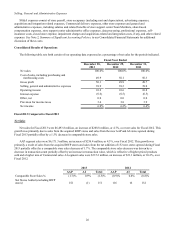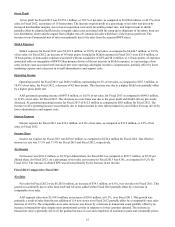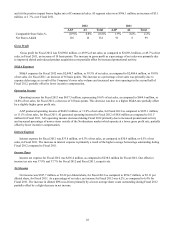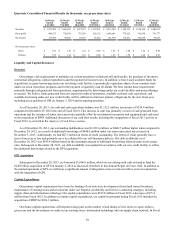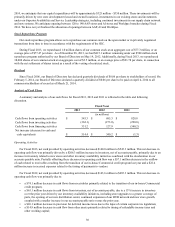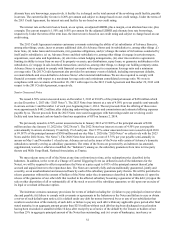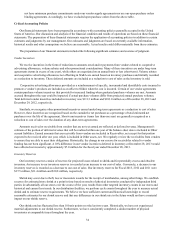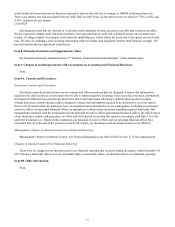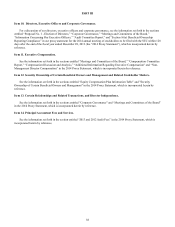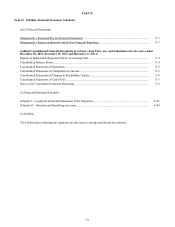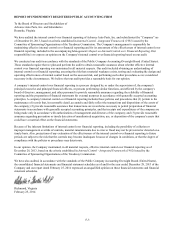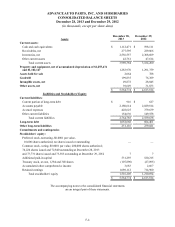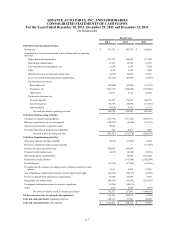Advance Auto Parts 2013 Annual Report Download - page 49
Download and view the complete annual report
Please find page 49 of the 2013 Advance Auto Parts annual report below. You can navigate through the pages in the report by either clicking on the pages listed below, or by using the keyword search tool below to find specific information within the annual report.36
We determine fair value using widely accepted valuation techniques, including discounted cash flows and market multiple
analyses. These types of analyses contain uncertainties because they require management to make assumptions as a
marketplace participant would and to apply judgment to estimate industry economic factors and the profitability of future
business strategies of our company and our reporting units. These assumptions and estimates are a major component of the
derived fair value of our reporting units. The margin of calculated fair value over the respective carrying value of our reporting
units may not be indicative of the total company due to differences in the individual reporting units, including but not limited to
size and projected growth. We have allocated our goodwill and indefinite-lived intangible assets within each of our reportable
segments to multiple reporting units in our AAP segment and to the entire AI segment, respectively.
During the year, management monitored the actual performance of the business relative to the fair value assumptions used
during our annual goodwill impairment test. For the periods presented, no triggering events were identified that required an
update to our annual impairment test. For the presented periods, the impairment assessments indicated that the fair values of
each reporting unit substantially exceeded the carrying values of the respective reporting units. We have not made any material
changes in the accounting methodology we use to assess impairment loss during the past three fiscal years. We do not believe
there is a reasonable likelihood there will be a material change in the future estimates or assumptions we use to test for
impairment losses on goodwill. However, if actual results are not consistent with our estimates or assumptions, we may be
exposed to an impairment charge that could be material.
Income Tax Reserves
The determination of our income tax liabilities is based upon the tax law, codes, regulations, pronouncements and court
cases for the taxing jurisdictions in which we do business. Our income tax returns are periodically examined by those
jurisdictions. These examinations include, among other things, auditing our filing positions, the timing of deductions and
allocation of income among the various jurisdictions. At any particular time, multiple years are subject to examination by
various taxing authorities.
In evaluating our income tax positions, we record a reserve when a tax benefit cannot be recognized and measured in
accordance with the authoritative guidance on uncertain tax positions. These tax reserves are adjusted in the period actual
developments give rise to such change. Those developments could be, but are not limited to: settlement of tax audits, expiration
of the statute of limitations, the evolution of tax law, codes, regulations and court cases, along with varying applications of tax
policy and administration within those jurisdictions.
Management is required to make assumptions and apply judgment to estimate exposures associated with our various filing
positions. Although Management believes that the judgments and estimates are reasonable, actual results could differ and we
may be exposed to gains or losses that could be material. To the extent that actual results differ from our estimates, the effective
tax rate in any particular period could be materially affected. Favorable tax developments would be recognized as a reduction in
our effective tax rate in the period of resolution. Unfavorable tax developments would require an increase in our effective tax
rate and a possible use of cash in the period of resolution. A 10% change in the tax reserves at December 28, 2013 would have
affected net income by approximately $1.8 million for the fiscal year ended December 28, 2013.
New Accounting Pronouncements
For a description of recently announced accounting standards, including the expected dates of adoption and estimated
effects, if any, on our consolidated financial statements, see New Accounting Pronouncements in Note 2 to the Consolidated
Financial Statements in this Report on Form 10-K.
Item 7A. Quantitative and Qualitative Disclosures about Market Risks.
Interest Rate Risk
Our primary financial market risk is due to changes in interest rates. Historically, we have reduced our exposure to changes
in interest rates by entering into various interest rate hedge instruments such as interest rate swap contracts and treasury lock
agreements. We have historically utilized interest rate swaps to convert variable rate debt to fixed rate debt and to lock in fixed
rates on future debt issuances. Our interest rate hedge instruments have been designated as cash flow hedges. We had no
derivative instruments outstanding as of December 28, 2013.
The interest rate on borrowings under our new revolving credit facility and term loan is based, at the Company’s option, on
adjusted LIBOR, plus a margin, or an alternate base rate, plus a margin. As of December 28, 2013, we had no borrowings
outstanding under our revolving credit facility or term loan. Subsequent to December 28, 2013, we borrowed on the revolving


